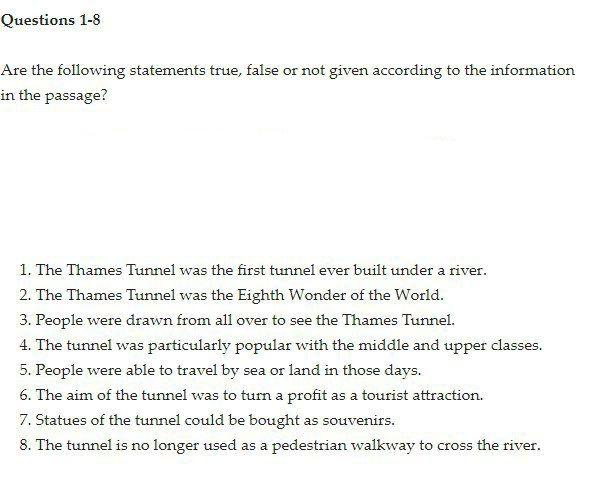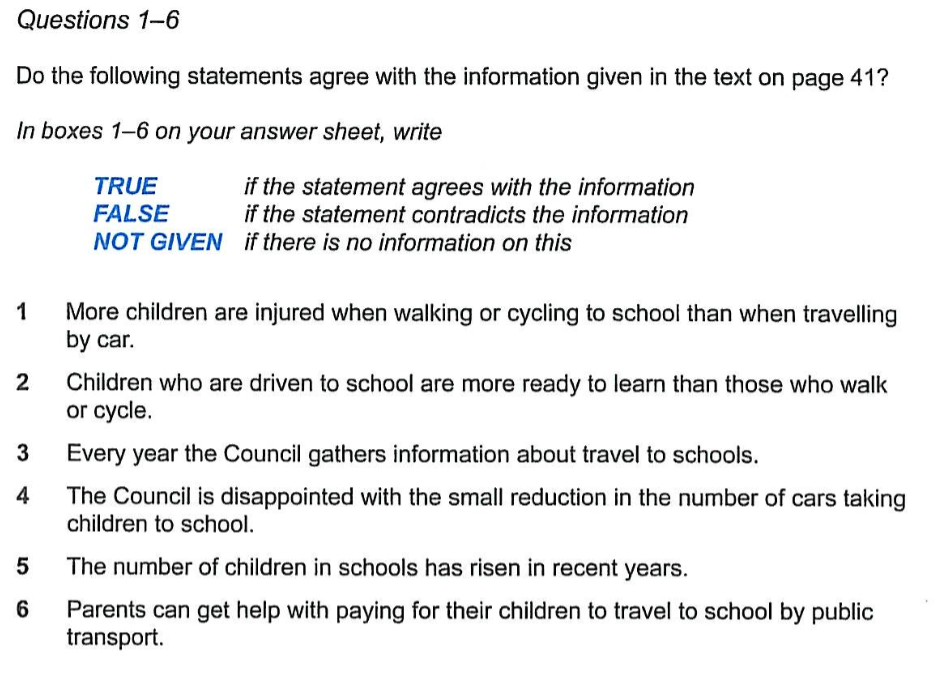
The “True-False-Not Given” questions occur in the IELTS Reading part. IELTS Academic Reading also has “Yes-No-Not Given” questions. They are similar to “True-False-Not Given” questions and you should answer them applying the same techniques.
You should understand whether the “claim” in the question is true or false, or there is not enough information about it in the passage.
Let me help you understand what True, False, and Not Given mean.
TRUE or YES
The statement is TRUE when the claim exactly matches the facts that are given in the passage. The claim does not have to be a word by word repetition of the text, search for paraphrased versions of the text.
FALSE or NO
The statement is FALSE when the claim (question) contradicts or is the opposite of the information provided in the passage.
NOT GIVEN
The statement is NOT GIVEN when you cannot tell if the statement is true or false after reading the passage. No evidence will help you decide whether it is true or false. It does not mean that nothing is mentioned about it; it just means that there is not enough evidence to determine if it is true or false.
Tips
Here we present the general tips for True, False, Not Given questions:
- Read the questions/statements carefully and make sure you fully understand them.
- Underline the keywords or the parts you think are essential and can help you find the information in the text.
- Keep in mind that they follow a chronological order. Once you find the answer to the first question, the second will come after that, and accordingly, the rest.
- Excessively pay attention to words such as “many, some, occasionally,” etc. They can change the meaning of the sentence.
- Don’t waste your time on one question. If you can’t find the correct answer after going through it several times, mark it Not Given. You will have a ⅓ chance of getting the right answer.
- Never leave a question unanswered. If you give the right answer, you will get extra marks. In case, you give a wrong answer, you will not lose any marks.
EXAMPLES
Let’s take these tips into consideration and solve an example together:
IELTS Reading – True False Not Given – Example 1


Answers:
- The question says, “first tunnel ever built under a river.” We look through the passage, and in the 2nd sentence of the text, we find this information: “the first subaqueous tunnel ever built.” we may not know what the word subaqueous means, but if we carefully read it, we can see it has two parts, “sub” and “aqua.” We know sub means under, and aqua means water. So, we can guess the meaning of the word. After comparing the two sentences again, we know the answer is TRUE.
- The second question mentions the information as it is a fact, but in the text, it says, “…many believed it was the Eighth wonder of the world at the time”. The text says it was something people believed; it is not a fact. Therefore, FALSE.
- “…drew people from far and wide.” The word draw in this text means “to attract” and “from far and wide” means from many places of the world. “From all over” means from many places of the world in this text. Therefore, we can see that the claim is TRUE.
- The passage does not mention if the tunnel was more popular with one class than the other, so NOT GIVEN.
- “In the age of sail and horse-drawn coaches.” Here sail means boats and transportation via the sea, and the horse-drawn refers to the roads. So this statement is TRUE.
- The text mentions, “The aim had been for the tunnel to be used by wheeled vehicles to transport cargo so that it could bring in a profit.” Whereas the question mentions that the aim was to gain profit as a tourist attraction. We understand it is FALSE.
- There is no information about what types of souvenirs were sold at the time there. So, the answer is NOT GIVEN.
- “In 1865, the tunnel became part of the London Underground railway system, which continues to be in use today.” As mentioned in the text, the railway system uses it and does not work as a pedestrian walkway. So TRUE.
IELTS Reading – True False Not Given – Example 2
Now try and solve this exercise yourself. This exercise is from the official Cambridge book 11, test 2.


Answers:
- NOT GIVEN
- FALSE
- TRUE
- FALSE
- TRUE
- NOT GIVEN

